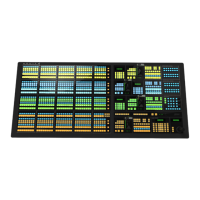Dynamic Host Configuration Protocol
An Ethernet protocol where a device, such as the
switcher, is given an IP address by the network host. This
eliminates the need to manually enter the network
parameters and IP address.
Field
One half of a complete picture (or frame) interval
containing all of the odd, or all of the even, lines in
interlaced scanning. One scan of a TV screen is called a
eld; two elds are required to make a complete picture
(which is a frame).
Frame
One complete picture consisting of two elds of
interlaced scanning lines.
File Transfer Protocol
A network protocol that is used to transfer les from one
host computer to another over a TCP-based network.
Gain
Gain represents the range of signal values present in a
video signal from a lowest to a highest point (from black
to white for example). Increasing gain expands this range,
while decreasing gain compresses this range. Clipping
occurs if applied gain changes cause output signal values
to fall outside the allowable range. Generally, increasing
the gain for a specic color component causes the video
signal colors to become increasingly saturated with that
color. Similarly, decreasing the gain for a specic color
component progressively removes that color component
from the output video signal.
Gamma
Gamma corrections introduce non-linear corrections to
a video signal. A gamma correction can be described as
taking a point on the output versus input video signal
line and pulling it perpendicularly away from the line.
The result is a Bezier curve between the start, the new
point, and the end point. Generally, increasing the gamma
value adds more of the component to the video signal in
the location of the gamma offset point. Decreasing the
gamma value reduces the amount of the component in
the video signal in the location of the gamma offset point.
Moving the gamma offset point allows you to select
which part of the input video signal receives the gamma
correction. For example, if you increase the red gamma
correction to the part of the video signal that has no red
component you will add red to those areas while having
little effect on areas that already contain a signicant
amount of red. This allows you to add a red tint to the
image while minimizing the amount of red-clipping that
occurs.
General Purpose Interface
A simple high/low signal that is used to trigger an action
either on an external device or on the switcher. A GPI
can be an input or an output to the switcher.
High Definition
A high denition (720p, 1080i, or 1080p/3G) video
signal.
Hue
The characteristic of a color signal that determines
whether the color is red, yellow, green, blue, purple, etc.
(the three characteristics of a TV color signal are
chrominance, luminance, and hue). White, black, and
gray are not considered hues.
Hue Rotation
Hue rotate affects the color of the entire video signal by
rotating the input video hues. This produces an output
video signal with colors that are shifted from their
original hues. By rotating colors around the wheel, hue
values will shift. For example, a clockwise rotation where
yellows become orange, reds become magenta, blues
become green. The more rotation applied, the further
around the wheel colors are shifted.
Interlaced
An Interlaced video format starts at the top of the screen
and draws all the odd number scan lines and then all the
even number scan lines in sequence. This results in half
the image being drawn in one pass and the other half of
the image being drawn in the second. These two passes
are called Fields, where the rst pass is called Field 1
and the second pass is called Field 2. When both Field
1 and Field 2 have been drawn, resulting in a complete
image, you have a single Frame.
Key
An effect produced by cutting a hole in the background
video, then lling the hole with video or matte from
another source. Key source video cuts the hole, key ll
video lls the hole. The video signal used for cut and ll
can come from the same, or separate, sources.
Key Alpha
The video signal which cuts a hole in the background
video to make a key effect possible. Also called Key
Video or Source. In practice, this signal controls when
a video mixer circuit will switch from background to key
ll video.
118 • Glossary — Acuity Operation Manual (v9.2)

